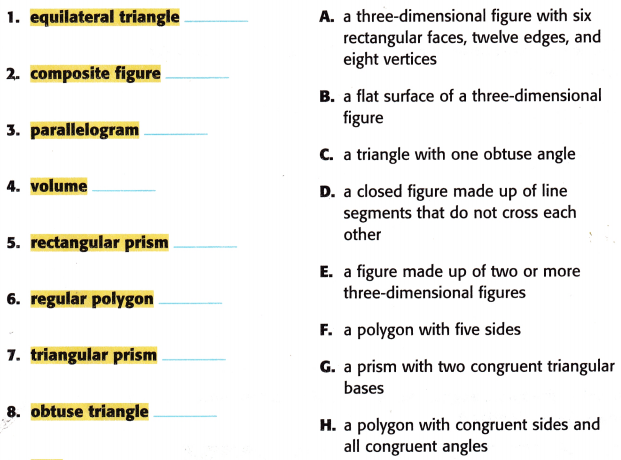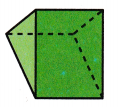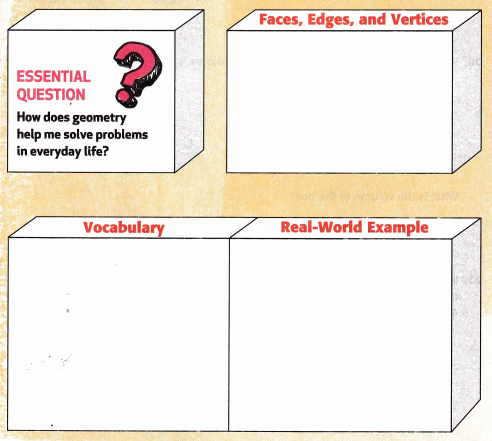All the solutions provided in McGraw Hill My Math Grade 5 Answer Key PDF Chapter 12 Review will give you a clear idea of the concepts.
McGraw-Hill My Math Grade 5 Chapter 12 Review Answer Key
Vocabulary Check
Match each word to Its definition. Write your answers on the lines provided.


Answer:


Concept Check
Name each polygon. Determine if it appears to be regular or not regular.
Question 13.

Answer:

– It is a geometric two-dimensional shape with five sides and five angles.
– It is an irregular pentagon.
– In an irregular pentagon, all the interior angles and the sides are of different measures.
Question 14.

Answer:

– A hexagon is a closed two-dimensional six-sided polygon. It is made up of six line segments and six vertices that form six internal angles.
– It is a regular hexagon.
– A hexagon is said to be a regular hexagon if the length of all the sides is equal and the measures of all the interior angles are the same. Also, the internal angle is equal to 120°. The regular hexagon consists of six symmetrical lines and rotational symmetry of the order of six.
Describe the attributes of each quadrilateral. Then classify the quadrilateral.
Question 15.

Answer:
– The opposite sides are congruent and they are parallel to each other.
– The opposite angles are equal.
– Therefore, it is a parallelogram.
Question 16.

Answer:
– It has four sides and four vertices.
– All the sides are congruent.
– opposite sides are parallel.
– All interior angles are equal and right angles.
– Therefore, it is a square.
Describe the faces, edges, and vertices of each three-dimensional figure. Then identify it.
Question 17.

Answer:
The number of faces = 6
The number of edges = 12
The number of vertices = 8
and moreover, the top and base are rectangles so it is a rectangular prism.
Question 18.

Answer:
The number of faces = 5
The number of edges = 9
The number of vertices = 6
– It has two triangular bases and three rectangular sides. So it is a triangular prism.
Problem Solving
Question 19.
A triangle forms the front of the Pantheon in Rome, Italy. Classify the triangle based on its sides. Then classify it based on its angles.

Answer:
It is an isosceles triangle.
Explanation: An isosceles triangle is a type of triangle that has any two sides equal in length. The two angles of an isosceles triangle, opposite to equal sides, are equal in measure.
– Angles of Isosceles triangle: The two of the three angles of the isosceles triangle are equal in measure, which is opposite to the equal sides. Hence, one of the angles is unequal.
Question 20.
Shawn keeps his photos in a box like the one shown.

What is the volume of the box?
Answer:
The above-given dimensions:
length of the box = 12
The width of the box = 4
The height of the box = 6
The volume of the box = V
We know that the volume of the rectangular prism formula:
The volume of the rectangular prism = length x width x height
V = 12 x 4 x 6
V = 288
Therefore, the volume of the box is 288 cubic inches.
Question 21.
Ishmail wants to build a long train track. If each piece of track is 6 inches long, and he has 42 pieces, can he make a track that is 20 feet long? Can he make a track that is 22 feet long?
Answer:
The above-given:
The number of inches each piece = 6
The number of pieces he has = 42
If we do 6 x 42. we get 252 inches.
Now we have to convert inches to feet
so divide by 12.
252 / 12 = 21
21 is greater than 20.
Therefore, he can make a track with 42 pieces.
Test Practice
Question 22.
Find the volume of the composite figure.

(A) 2,700 in3
(B) 2,780 in3
(C) 3,420 in3
(D) 3,660 in3
Answer: Option C is the correct answer.
Now we need to split into two rectangular prisms and find the volume of each prism.
The bottom prism:
The above-given dimensions:
length = 25
The width = 9
Height = 12
The volume of the rectangular prism = length x width x height
V(bottom) = 25 x 9 x 12
V(bottom) = 2700 cubic inches.
The top prism:
The above-given dimensions:
length = 8; width = 9; height = 10
V(top) = 8 x 9 x 10
V(top) = 720 cubic inches.
The total volume = V(bottom) + V(top)
V(total) = 2700 + 700
V(total) = 3420 cubic inches.
Reflect
Use what you learned about geometry to complete the graphic organizer.

Now reflect on the ESSENTIAL QUESTION Write your answer below.
Answer:
– Studying geometry gives us knowledge and builds concepts related to shapes, surfaces, volumes, lines, angles, etc.
– Studying geometry provides students with many foundational skills and helps to build the necessary skills in life.
– At a basic level, geometry subject is important as it creates a foundation for the more advanced mathematical learning that lies ahead.
Faces, edges, and vertices:
Vertices, Faces and Edges are the three properties that define any three-dimensional solid. A vertex is the corner of the shape whereas a face is a flat surface and an edge is a straight line between two faces. 3d shapes faces, edges and vertices, differs from each other.
– In our day-to-day life activities, we come across a number of objects of different shapes and sizes. There are golf balls, doormats, ice-cream cones, coke cans and so on. These objects have different characteristic properties such as length, breadth, diameter, etc., which set them apart from one another. But no matter how different their dimensions are, all of them occupy space and have three dimensions. So they are referred to as three-dimensional shapes or solids.